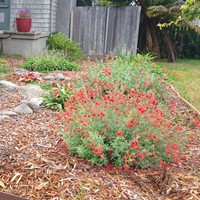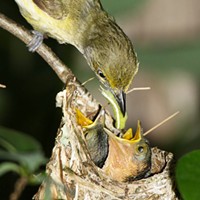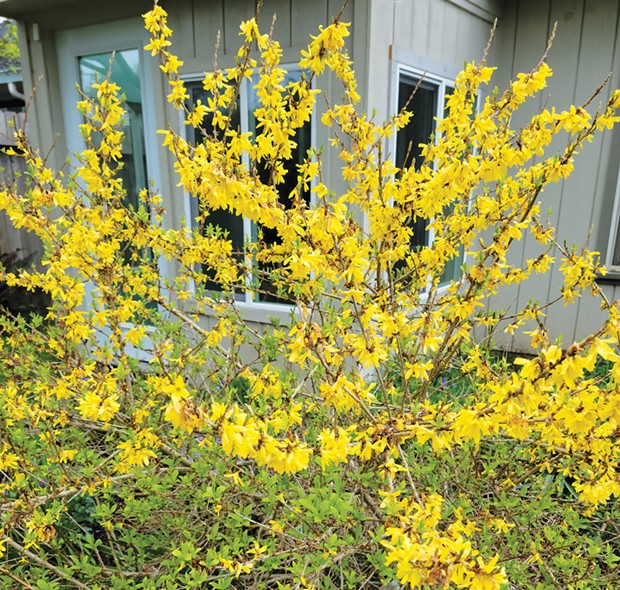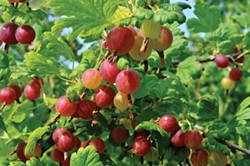[
{
"name": "Top Stories Video Pair",
"insertPoint": "7",
"component": "17087298",
"parentWrapperClass": "fdn-ads-inline-content-block",
"requiredCountToDisplay": "1"
}
]
I follow more than a few plant and picture pages on social media, and it's always interesting to see folks wax poetic about some of our more aggressive invasive plants. Often, they (the people) are transplants to the area and these plants aren't an issue where they come from, but there are also people who just think that Scotch broom is "so so pretty!" Well, yes, it is pretty. I can't disagree with that, but it's also taking over hillsides and shoving out many of the native plants. So rather than jump on the less constructive don't-plant-that-you-doofus wagon, I thought I'd offer up some alternatives to the pretty plants that are taking over just about every area of the county.
Let's start with Scotch broom (and its cousin, French broom). It's a noxious invasive that has taken over many areas on the West Coast. It loves acidic soil, which is partly why it's so successful here on the coast. When it goes to seed, the plant literally bursts open the seed pod with an audible crack, flinging seeds far from the parent plant. But what about those pretty yellow flowers?
Here are a few plants that you can plant instead (not that you'd actually plant Scotch broom, because that would just be crazy): California goldenrod, California gumweed and golden yarrow or yellow yarrow, all of which are native. Another beautiful plant with long-lasting yellow blooms is the forsythia (not a native plant), which you see blooming around town starting in early February, lasting for a couple months if the weather conditions are right.
Let's talk about knotweed next. It has these beautiful, fluffy, white flowers, usually appearing in July. It was originally planted as erosion control and, girl howdy, was it successful! It was also successful at taking over every other plant that grows near streams. Rather than knotweed, try planting goatsbeard, also known as bride's feathers. It's often found in mountainous regions. The flowers are featherlike and grow on leafless branches. Another option is silk tassel. An excellent stand of this native plant can be seen in the landscape of the Humboldt Area Foundation on the Indianola cutoff in Eureka.
Another plant people go on and on about on various Humboldt County Facebook pages is yellow lupine. It's all over our local beaches and along the roadsides throughout the county, especially heading out toward Samoa and Manilla, as well as along U.S. Highway 101. Rather than this plant, consider planting bigleaf lupine. Sure, it's not yellow but it has gorgeous stalks of flowers that are deep blue to purple, which is a favorite for pollinators such as native bees, bumblebees and honeybees. Bigleaf lupine is considered invasive in parts of Europe and New Zealand, but, so far, it's remained a well-behaved plant here on the North Coast. The non-native yellow lupine is so invasive, Friends of the Dunes holds its "Lupine Bash event annually to get at least some of it pulled out. If you need a place to take out your frustrations and irritation, I highly recommend taking part in this festive little event. I believe it was on hold due to COVID but watch for more upcoming Bashes on FOD's page www.friendsofthedunes.org.
Next up is one of my top plants I would eradicate if I could but I cannot because I am only one mere human: pampas grass. Gah. It's taking over the hills, dunes and beaches. It will also easily and quickly take over disturbed areas, such as a wildfire or a clear-cut (there's a small example on Elk River Road). Rather than this noxious invasive, consider planting Pacific Reedgrass, aka Nootka Reedgrass, which is native to our area. It also prefers coastal areas, dunes, coastal woodlands and riparian areas.
Another lovely native grass is tufted hair grass. This grass closely resembles pampas grass in the blooming stalks. It also tolerates shady areas.
Another showy invasive I always beg clients to yank out when it's young is cotoneaster. It has deep green leaves and clusters of red berries that birds find very appealing, which is why they are easily spread everywhere. Everywhere. They have a nasty taproot once they get established, and it's quite difficult to pull out, even as a wee plant. Please don't plant these and if you have them in your landscape, rip them out. Alternatives to these pretty red berry plants include: California coffeberry, cascara, bearberry, currant and gooseberry (the last two produce edible fruits, so that's a bonus).
These are just a few of the alternatives to invasive species here on the North Coast. As luck would have it, the California Native Plant Society is about to hold one of its annual sales. The spring event will be held on Saturday, April 30, and Sunday, May 1 at Freshwater Farms Reserve (5851 Myrtle Ave., Eureka). You need to sign up in advance so that there won't be too many people crowded into the area all at once. You can sign up for a slot at www.northcoastcnps.org. Find more native species at the Humboldt Botanical Garden plant sale May 7 from 9 a.m. to 3 p.m. (the May 6 preview from 3 to 7 p.m. is for members only). Visit www.hbgf.org for details.
Julia Graham-Whitt (she/her) is owner and operator of the landscaping business Two Green Thumbs. She wrote this article in collaboration with Mir de Silva, who, in addition to being the other Green Thumb, is a local artist and illustrator. You can find her on Instagram at @art.by.Mir.
Speaking of...
-

Equinoctial To-Do and Native Plants
Sep 21, 2023 -

Gardening for Caterpillars?
Dec 15, 2022 -

NCJ Preview: The Green Issue
Apr 17, 2022 - More »
Comments
Showing 1-1 of 1
more from the author
-
Working it Out in the Garden
- Jan 18, 2024
-
Winter Planting for Future Color
- Dec 21, 2023
-
Equinoctial To-Do and Native Plants
- Sep 21, 2023
- More »

































